On the Preposterousness of Centering a Fat Body: Liberation and Exile in Iiu Susiraja’s Self-Portraits at MoMA PS1
By Nina HerzogAugust 15, 2023
:quality(75)/https%3A%2F%2Fdev.lareviewofbooks.org%2Fwp-content%2Fuploads%2F2023%2F08%2Fcoversmall00_1064x.jpg)
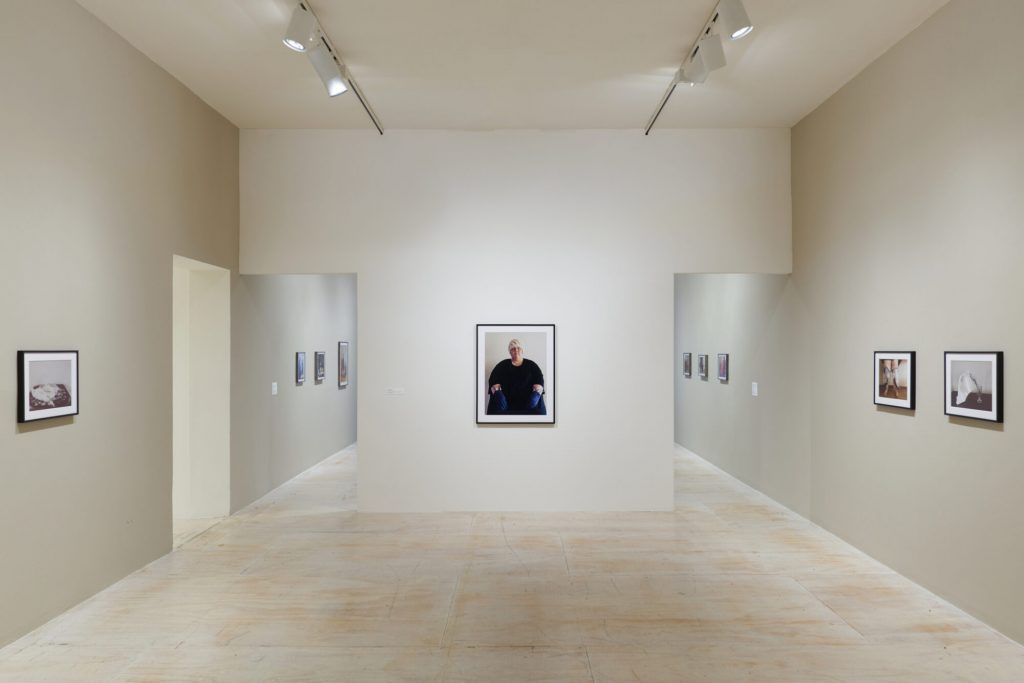
Susiraja began taking photographs at the age of 32, just 15 years ago. Upon getting a camera, she turned it on herself. She works primarily in photography and video, though a simultaneous solo show at Nino Mier Gallery in Tribeca, New York, called Hot Stuff (May 19 to June 17), added sculptural 3D-printed plastic representations of the objects in her photographs and videos for the first time.
Susiraja is, as art historian and curator Kati Kivinen has observed, in many ways a classic milieu portraitist, relying in almost every work on the simple framework of her own image and a familiar background or setting, adding one or more objects. In her videos, she completes single projects, shot in uninterrupted takes that are usually around one minute long. In Humble Omelette (2020), Susiraja, standing in her kitchen, removes an egg from the refrigerator, holds it carefully between her chin and breastbone, then brings her chin down to crush it, yolk and white dribbling down her muted-gray floral dress. The shell cracks against the floor and she walks out of the frame. In Raining 1 (2017), she spits onto the inside of an umbrella, then turns it above her so the spit rains down inside, plopping onto the ground. The effect lies in the paradox of these disquieting gestures. Every gesture, every image, is defiant and undermining. In the simplest terms, she is always doing something wrong.
Susiraja herself serves as the center of gravity around which all her objects orbit. And because her body is large, and because a body of this size is itself perceived as an aberration and transgression (as she has named it: “If a fat person behaves badly […] then they are doubly misbehaving. Being fat is a transgression in itself”), it becomes the one repeating subject of every work of self-portraiture, by default. This content becomes a socially prescribed and inescapable value of her work, and she both embraces and dismisses its meaning while expertly mining its power. To center and display her body so matter-of-factly, devoid of shame, devoid of pride, is to immediately disorient and confound. This is an act of profound confidence. Within this confidence, there is freedom. This freedom is preposterous.
The only near-constant in the works, other than Susiraja herself, is the face she wears—her ever-present blank gaze, her expressionless eyes, unmoving and fixed on the camera (“I try to reach as blank a state as possible. […] For me, being blank is the same as being real”). Before we’ve even begun to stare at her and the predicament she’s concocted, she’s staring at us. Being stared at is a familiar and unnerving stance for those of us who, like Susiraja, navigate the world in superfat bodies. She works to be “empty,” and this blankness is perhaps her trademark. It provides her with distance, an impassivity that seems to disconnect her from the impact of the work. Almost like, I am doing this, but I’m not here. This effort to vacate the circumstance she has created, this willful exiling of the self within the work, is not just the foundation of her art but also an intentional and organic result of her simple task-oriented process, which distances itself from traditional notions of inspiration or intention or storytelling. This exiling of the self is also a necessary by-product of her content: Susiraja herself, meeting an unreliable and unsafe world. I asked her in an email how she felt while making her art, in a futile effort to uncover what was under that blank stare. “I do not feel anything,” she said. “I am empty. I just focus on doing.”
In a 2019 interview for her Dry Joy show, she spoke of her relationship with objects:
In my pictures I speak through objects. The object strives for symbiosis with me. I see the action as being contained in the object, which is just waiting for someone to blow some life into it. The object is a tool for experiencing partnerships. The act of photographing it brings it from the background into the limelight.
She creates lists of objects while listening to music and then goes to “fetch” them: “It all starts with the object. […] My starting point is purely the object and how it relates to me.” Household items are favorites—broom, frying pan, mirror, clothes dryer, electric saw, drill—and sometimes get sexualized via their position next to her, like an umbrella resting at her crotch, an oversized stuffed teddy bear positioned with its head between her legs, or a baguette secured in place by her breasts.
In her lead essay, “Heart-Shaped Box,” featured in MoMA PS1’s A style called a dead fish exhibition book, Jody Graf, the show’s curator, notes that food serves as both object and medium in the artist’s work: “Susiraja has a particularly materialistic attitude towards food, because for her it is an artistic medium, like paint or clay are for other artists.” She favors food iconic of laziness or indiscretion (bacon, cupcakes, hot dogs, cake), though fish, perhaps the most redolent food signal, with its accompanying cheap cultural overtones of female sex, makes frequent appearances. Slabs of meat, still in their supermarket packaging, stand in as romantic objects, as in Husband (2021), where she is wearing a white embroidered dress and holding a supermarket meat slab with a men’s tie around it at her chest. She borrows the meaning we’ve attached to these items, knowing it gets magnified in relation to a fat person.
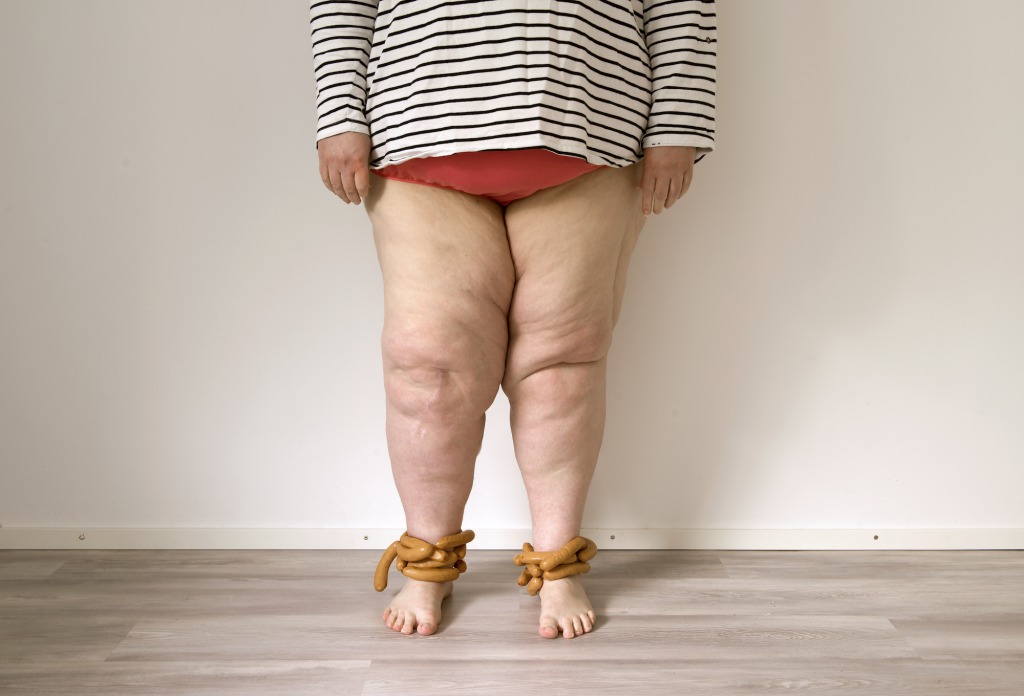
Conversely, Susiraja’s figure also seems to take on the meaning of its surrounding objects, and is tainted by them, as they influence how we see it. She becomes one of the objects. In titling a photo of herself and a balloon tied by a string wrapped around the tip of her nose Duo (2017), she seems to suggest they are the same. In Self-Service (2009), she has tucked a tray under her belly as if it is ready to serve, like a warm loaf of bread straight out of the oven. At times, her head remains outside the frame, as in Ankle Weights (2017), a photo taken from the belly down with sausages wrapped around her ankles. She is capitalizing on the inherent, easily recognizable, and universal meaning, also “charged,” of her fat body and the idea of serving it up.
As Johanna Fateman wrote in The New Yorker in May 2022,
Susiraja practices a perilous form of physical comedy. A fat woman is by cultural default already an object of ridicule; inviting laughter by clenching a baguette between her legs, or ironing a pizza to her chest, could easily spin out of her control. Perhaps Susiraja’s blank affect is the key to her peculiar power to retain the upper hand. Indifference is one of the purest forms of defiance, but her disciplined impassivity, her refusal to cue the viewers’ reaction, is more than that. Her unwillingness to feed us meaning is more provocative, and disquieting, than an obvious dare, and it leaves a more lasting impression.
Susiraja’s comedy is most often satirical or ironic. And sometimes the meaning is clear and the comedy tragic. In Clown is trying to be magician’s bunny (2018), Susiraja is wearing a floral-patterned dress, her face spotted with six bright red clown noses, one foot resting gingerly inside a magician’s hat on the floor. She doesn’t fit. She doesn’t fit in. “I’m not able to always describe what the photos are about. But I want to make you feel the same feelings I have felt,” the artist has said.
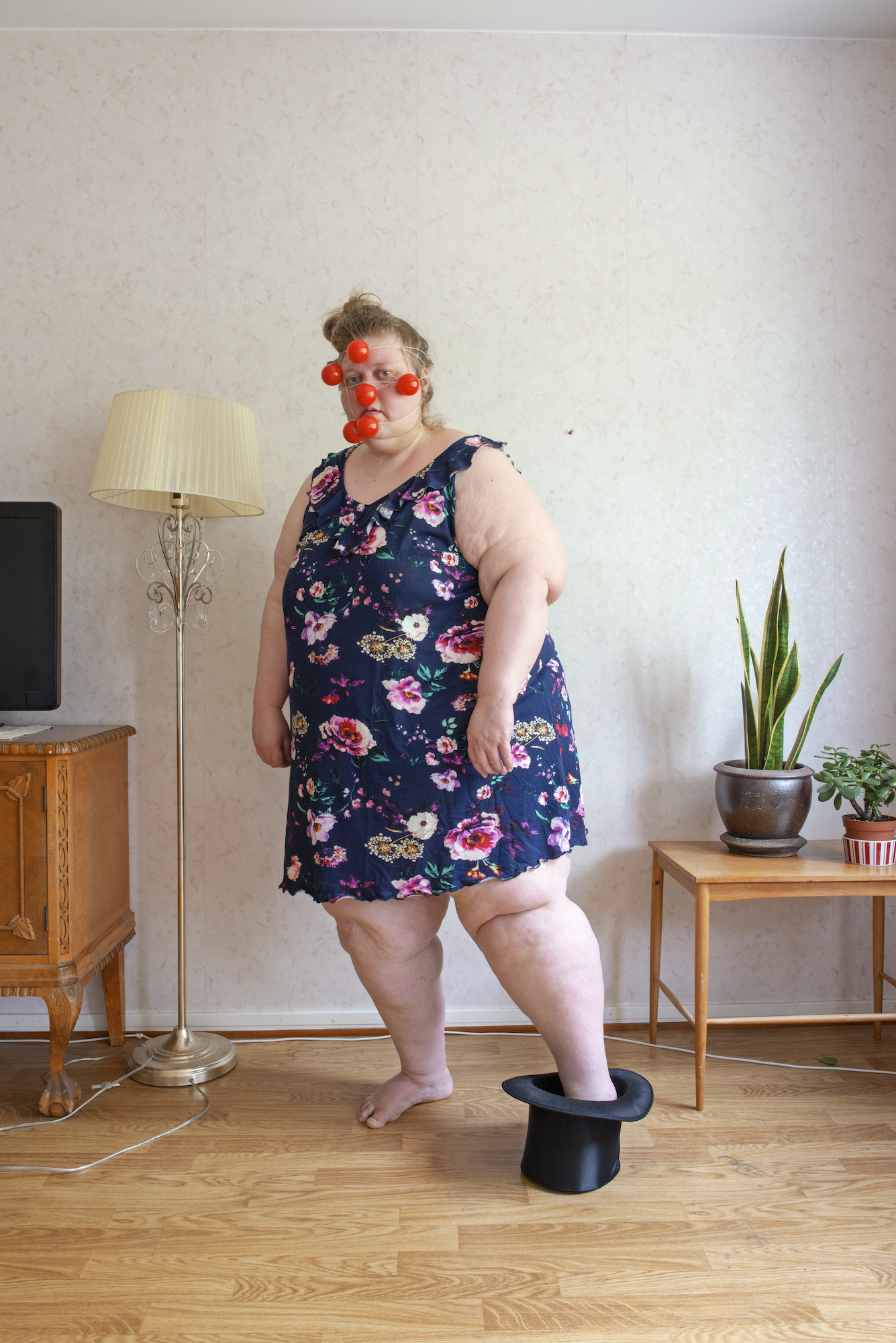
Although Susiraja consistently denies any overt political intention in her work, Alex Jovanovich, the reviews editor at Artforum, has pressed her on the topic. He interviewed her to coincide with his February 2022 cover story on the opening of her solo show Women’s Work at Nino Mier Los Angeles:
Jovanovich: One of the reasons I’m so drawn to your work is because of the way you present your […] fat body. I have a fat body, too, and it’s something that we don’t see, in contemporary art, too much of. […] It’s weirdly taboo. […] So, I wonder, is there any kind of political intention behind this sort of fat representation?
Susiraja: Well […] when it comes to politics or taking a stand, […] they are not starting points for me. […] I do like that politics and opinions appear there. I do like that, as it again adds another layer, but I don’t deliberately put it there. It’s the same thing with fatness: that isn’t the starting point for my art either. […] [T]he starting point in my art is the object, and then these other things appear in the mix very organically, like different beauty standards, feminism, or these kinds of things. It’s a good thing, because I think if I was to put it all there deliberately, […] my art wouldn’t work so well.
In curating the MoMA PS1 show, Jody Graf is faithful to Susiraja’s intentional distancing from meaning, retaining her stance of “ambiguity.” The show is noticeably devoid of the usual supporting text intended to provide historical context or deeper insight about the works, except for a few brief sentences at the entrance to the exhibition. Graf told me:
Iiu has underscored the fact that her work is not prescriptive; she doesn’t consciously approach her work with a particular message to convey, and invites multiple interpretations. She shies away from explanation, and language rarely enters the equation for her (though when it does, as in her titles and poetry practice, it is telling). This puts more of an onus on the viewer to explore the images without a concrete narrative being handed to them. It was important to me to retain this space of ambiguity, which is where I believe a lot of the political work of the images occurs. […] By refraining from prescribing a single narrative or interpretation, Iiu offers space and induces the viewer to consider the stories and baggage that they carry and map onto the images.
By insisting she has no stance, that her work is apolitical, and by betraying nothing in her face, Susiraja effectively vacates the premises and leaves us to stew in our own emerging responses, whether they are disbelief, exhilaration, disgust, or confusion. She has done the work of setting up the experiment, but its results become our problem, our responsibility. Perhaps this rather karmic approach to disruptive art—simply showing us what we came with, or making the internal external—is treating us like adults. But are we, in this case? “My photography gives freedom to the viewer,” Susiraja has said. Perhaps we’re still immature in our social construction of fatness, not quite ready to be trusted.
I usually find museum text annoying, mostly because I have trouble understanding it and it makes me feel stupid. (Clearly, I’m not an adult.) But Graf’s introductory essay was clear, smart, interesting, and written with sensitivity, handling the issue of fatness with unexpected expertise and grace. She earned my trust. I found myself wishing that she had taken on the unenviable task of guiding legions of unsuspecting and uninitiated viewers through the basics of critical fat studies that are on display in her essay. Suddenly, I felt they had been deprived of the experience of managing this difficult and unfamiliar terrain with a worthy and trusted adult.
Despite Susiraja’s insistence that she is not intentionally sending a message with her art, her work nonetheless speaks. And what it says is political, radical, and disruptive. Moreover, it uses a megaphone.
There is something unsettling in this reluctance to name the subject and political nature of her work. It is an everyday exhaustion to maintain your self-worth in a social, cultural, and political context where media representations of fat people often present them headless, decapitated, a spectacle of failure (cue the news clipping on “obesity” with a body sitting on a bench holding a packet of French fries, head outside the frame), the near-universal messaging that something is very wrong with you, that your body epitomizes ugliness. The only viable antidote to this daily onslaught is community. And community arises from naming as an act of opposition. I am fat. I have always been fat. Iiu Susiraja, an astounding artist whose medium is self-portraits, is fat.
Indeed, when I asked Artforum’s Jovanovich what Susiraja’s work meant to him, he said:
The thing I love most about Iiu’s work is how uncomfortable it makes thin people. Fat folks typically do what’s necessary to disappear themselves, even though they are frequently the most visible entities in virtually every situation. Iiu does the exact opposite—she places her big body front and center in all of her pictures, searing her image into people’s brains […] with crazy props and garish sets to boot! She is not “subtle” or “minimal” or insipidly “tasteful” in her approach—terms that are intellectually synonymous with thinness. The art world is notoriously lookist, and her work fucks with all of that in smart, blunt, and beautiful ways.
It is important to appreciate how measured and steady Susiraja’s public comments are. She talks about objects, process, blankness, completing simple “tasks.” She also talks about protection and distance, how to keep herself safe. While she concedes that her work comes from her own experiences—one reason she gives for using herself as both subject and object—she does not reveal the backstory, saying, “I also want to protect myself a bit.” And I can’t help but appreciate the enormity of this burden.
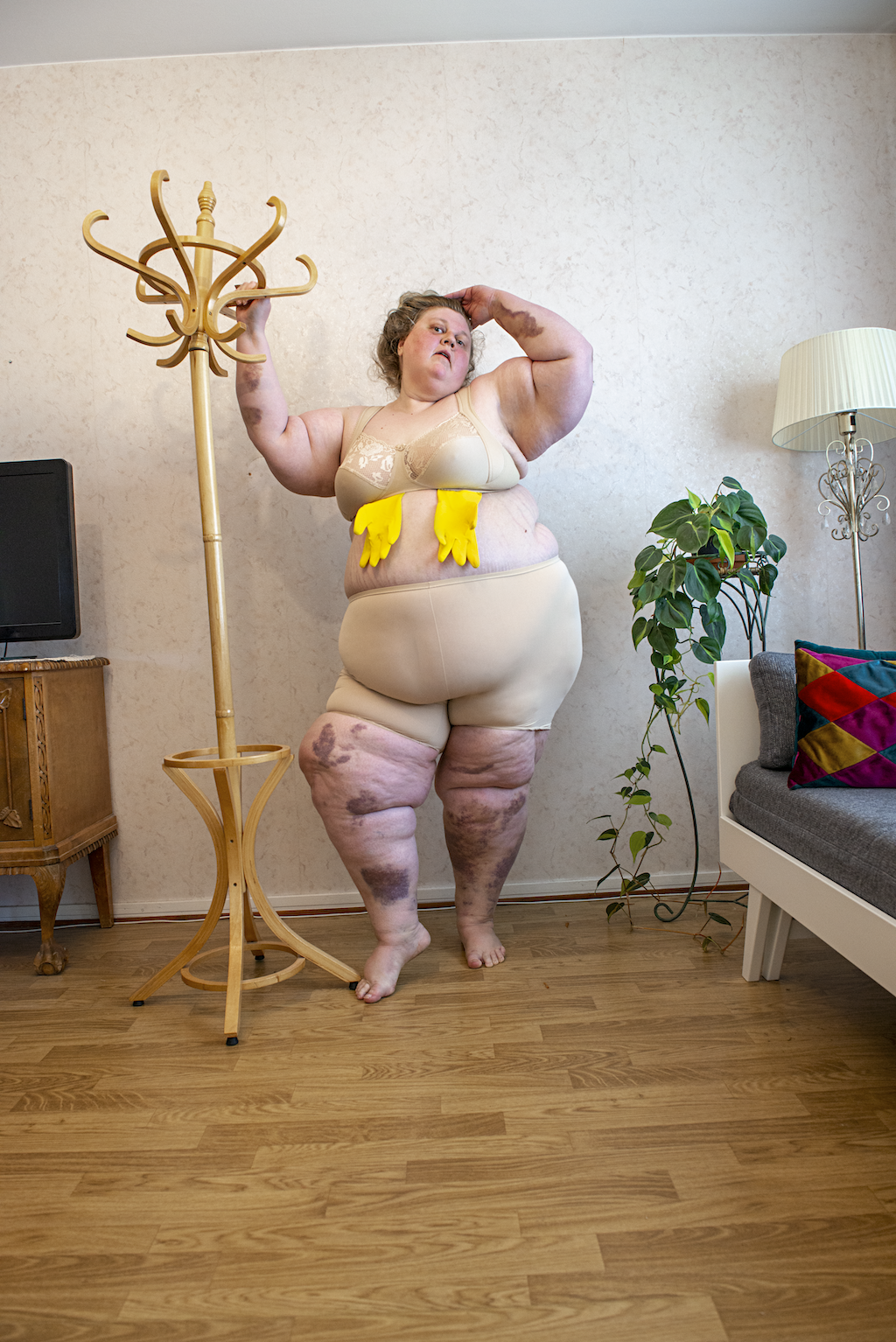
In the Dalmatian (2019) series, where she uncharacteristically poses in a “flirty” manner (an approach suggested to her by her mother), she has bruises all over her body and face. She took these photographs working daily over the course of two weeks while taking painkillers. Jovanovich has noted the “violence or darkness” in her work, “right beneath the surface.” Here the violence is on the surface, on her skin, on display. Again, she keeps the background story private. We don’t know the origin of the bruises or if they involved violence. But the dark marks of pain on her skin are wrenching.
Objects, her recurrent and worthy foils, are also a form of protection. “That’s part of the reason why I include objects, because they provide some distancing,” she has said. “Without the object, the picture might be too revealing.” It feels important to connect Susiraja’s content and process and to explore the nature of their relationship. Her procedural need to be empty may be more than an artistic choice; it may also be protective. (“Empty stare is my shield.” And of her images, she has said, “I am empty but alive.”) There is a survival here. The content is personal, difficult, and repetitious, and therefore involves a level of sustained vulnerability that must be both taxing and dangerous. Susiraja has given the “safe environment” of the home as one reason she relied on the familiar, private setting of her own home or her parents’ home in her work through 2018, after which she expanded to a hotel room and then a private studio, experimenting with colorful backdrops. Again, from her interview with Jovanovich: “[I]t was very hard in the beginning to look at the self-portraits, but the more and more I looked at them and took new self-portraits, you become numb and you accept it and yourself.” Graf understands this and named it when I asked her what the response to her show has been:
[The] complexity [of her work] appears to be more easily disregarded when images of Susiraja’s works are posted online, leading to knee-jerk and often fatphobic reactions. Susiraja’s work can make people uncomfortable. Certain forums are better suited to reflecting on that discomfort, rather than redirecting it back as aggression. If anything, this show has given me renewed faith in the exhibition as a fruitful format and space for collectively dealing with complicated ideas.
I was curious, in a rather frightened way, about the public response in other recent settings, having followed Susiraja’s work on Nino Mier’s Instagram account and read the vile comments that emerge from people behind the internet’s cloak of anonymity. So I asked Jovanovich about her Artforum cover. He said that the response was “weirdly, overwhelmingly positive. There are always trolls, of course. But I was astonished by how many people were behind it!” I asked Maya Code-Williams, artist liaison for Nino Mier Gallery in Tribeca, about their concurrent solo show: “The response to the show has been overwhelmingly positive. Specific reactions have ranged from finding the work to be funny, charming, clever, confronting, bold, honest, poignant, powerful.” And from Jody Graf, “The reception […] has been overwhelmingly positive, most gratifyingly amongst those who have admitted to being somewhat skeptical about the work in the past.”
The reviews are in. The public reception of Iiu Susiraja in New York City has been uniformly “overwhelmingly positive.” What’s going on?
For some of us, this is a political struggle. On May 26, about a month after the show’s opening, New York City became the largest municipality to pass a law against discrimination based on weight and height in housing, employment, and public accommodation. Activists and a coalition of organizations had come together to create the Campaign for Size Freedom. Binghamton (in New York) and San Francisco are other cities that have anti–fat bias laws, and Urbana, Illinois; Madison, Wisconsin; and Santa Cruz, California, have bans against discrimination relating to personal or physical appearance or attributes. Only one state, Michigan, and one district, Washington, DC, have outlawed fat discrimination, though New York, New Jersey, Vermont, and Massachusetts are considering similar laws.
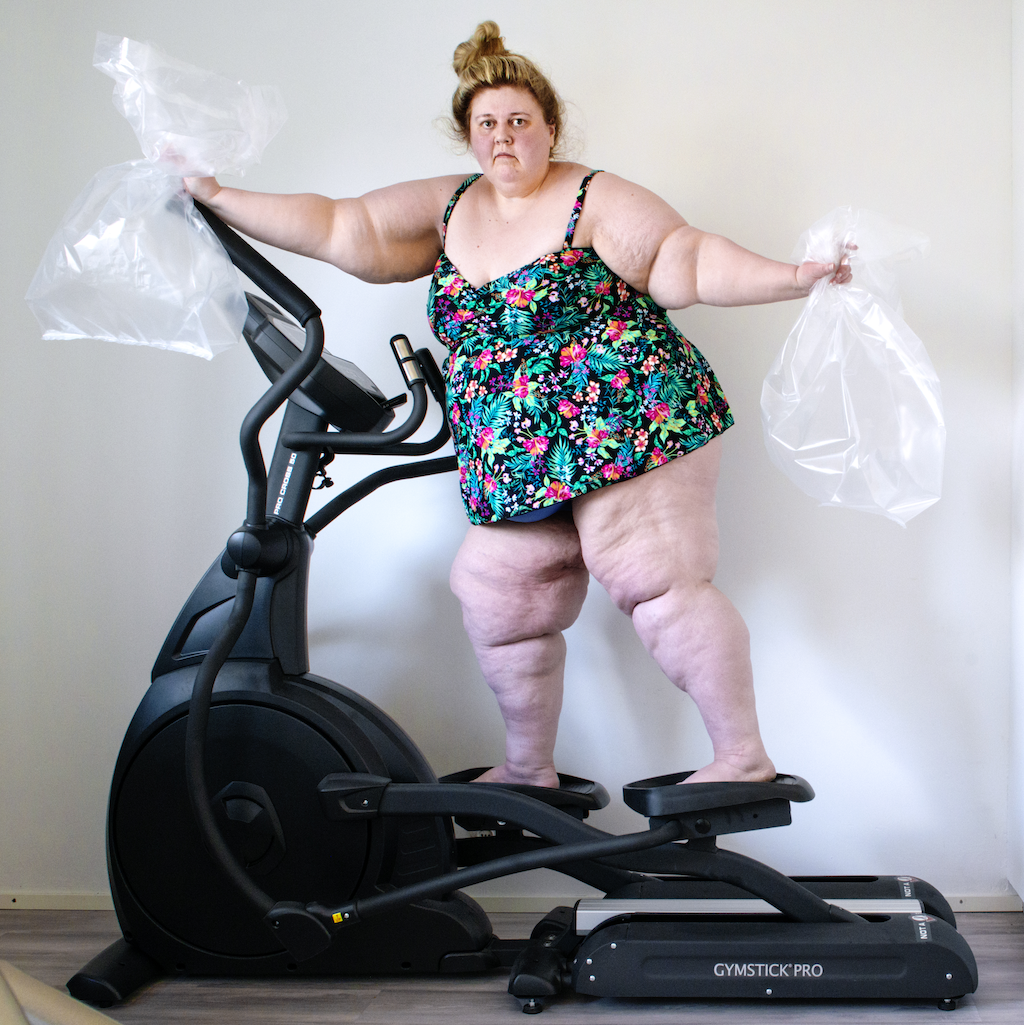
As a society, we are not yet comfortable with the notion that a stigma against fat people is uncalled for or wrong. The New York City law is setting a new bar, naming fat people as a newly protected class. Still, society remains caught in the erroneous belief that fat can and should be fixed—that it is a reversible condition that results from laziness, self-indulgence, lack of discipline or self-control, or unnamed other character flaws. We believe that we shame fat people for their own good.
It is the preposterousness of these views that undergirds Susiraja’s work. She goads and picks at these norms, challenging them with every sausage tied around her ankle and every cake tucked into her underwear. Through her satire and irony, her skillful use of her own fat image, she is in fact protesting—with “quiet arrogance,” as she has called it—these vapid and tired tropes. In Airplane (2020), she sports a one-piece floral bathing suit, feet planted resolutely on a large aerobic exercise contraption, arms extended like wings. In each extended arm she holds, almost triumphantly, two clear plastic bags filled with air, with emptiness.
¤
All the works named herein are on view at Iiu Susiraja: A style called a dead fish, at MoMA PS1 in Long Island City, Queens, New York, from April 20 to September 4, 2023, except Self-Service (2009), which is featured in the exhibition’s book, and Husband (2021), viewed on the artist’s Instagram account.
Artwork images courtesy of the artist, Makasiini Contemporary, and Nino Mier Gallery. First installation view courtesy MoMA PS1.
¤
Nina Herzog is a writer and psychotherapist living in New York. Her writing has appeared in the Los Angeles Review of Books, Tin House, Tricycle, and Words Without Borders, among other publications.
¤
Featured image © Iiu Susiraja, Lucia, 2010. Cover, Artforum, February 2022.
LARB Contributor
LARB Staff Recommendations
Carnal Thoughts: On Alice Blackhurst’s “Luxury, Sensation and the Moving Image”
Adèle Cassigneul reviews Alice Blackhurst’s “Luxury, Sensation and the Moving Image,” and, in doing so, interrogates feminist artistic constellations...
All Hail the Guilty Pleasures: On Ali Liebegott’s “Rooms and Other Feelings”
Michelle Tea reflects on the paintings of artist and writer Ali Liebegott in the exhibition “Rooms and Other Feelings.”
Did you know LARB is a reader-supported nonprofit?
LARB publishes daily without a paywall as part of our mission to make rigorous, incisive, and engaging writing on every aspect of literature, culture, and the arts freely accessible to the public. Help us continue this work with your tax-deductible donation today!